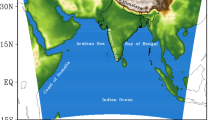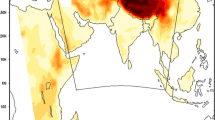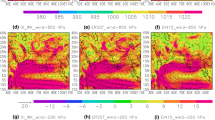Abstract
A comprehensive understanding of the variation of Indian summer monsoon (ISM) features is necessary for accurate prediction of seasonal and sub-seasonal scale meteorological parameters. In this study, the summer monsoon features over India are investigated using RegCM simulations over South Asia Coordinated Regional Downscaling Experiment (SA-CORDEX) domain with 45-km spatial resolution. The initial-boundary data are derived from the European Centre for Medium Range Weather Forecasts Re-Analysis (ERA) and Geophysical Fluid Dynamics Laboratory (GFDL) analysis for the period 1989 to 2005. For both model simulations, mixed convection scheme (Emmanuel over ocean and Grell over land), Holtslag planetary boundary layer (PBL) scheme and biosphere atmospheric transfer system (BATS) land surface scheme are used throughout the experiment. The simulation results are validated with Climatic Research Unit (CRU) observations of precipitation and temperature. The spatial distribution of precipitation and temperature is reasonably simulated with ERA and GFDL analysis as compared with CRU observation. However, the simulation of precipitation and temperature with ERA analysis iscloser to CRU observations as compared with GFDL analysis. The seasonal scale (JJAS) simulation of precipitation with ERA and GFDL illustrates wet bias (2 mm per day) as compared to CRU observation, whereas temperature simulated with ERA indicated warm bias (1 °C) and GFDL depicts cold bias (2 °C) against CRU observations. The wind magnitude and distribution of ERA simulations show considerably higher magnitude over the western Himalaya which is connected to low values of specific humidity over the same terrain as compared with GFDL.











Similar content being viewed by others
References
Bhaskaran B, Jones RG, Murphy JM, Norguer M (1996) Simulation of the Indian Summer Monsoon using a nested regional climate model: domain size experiments. Clim Dyn 12:573–578
Chandrasekar A, Kitoh A (1998) Impact of localized sea surface temperature anomalies over the equatorial Indian Ocean on the Indian summer monsoon. J Meteor Soc of Japan 76(6):841–853
Choudhary A, Dimri AP (2019) On bias correction of summer monsoon precipitation over India from CORDEXSA simulations. Int J Climatol 39(3):1388–1403
Fritsch JM, Chappell CF (1980) Numerical prediction of convectively driven mesoscale pressure systems part I: convective parameterization. J Atmos Sci 37:1722–1733
Gadgil S, Rajeevan M, Nanjundiah R (2005) Monsoon prediction—why yet another failure. Curr Sci 88(9):1389–1400
Giorgi F (1990) Simulation of regional climate using a limited area model nested in a general circulation model. J Clim 3:941–963
Giorgi F, Coppola E, Solmon F, Mariotti L, Sylla MB, Bi X, Turuncoglu UU (2012) RegCM4: model description and preliminary tests over multiple CORDEX domains. Clim Res 52:7–29
Giorgi F, Jones C, Asrar GR (2009) Addressing climate information needs at the regional level: the CORDEX framework. World Meteorological Organization Bulletin 58(3):175
Giorgi F, Marinucci MR, Bates GT, De Canio G (1993b) Development of a second-generation regional climate model (RegCM2) part II: convective processes and assimilation of lateral boundary conditions. Mon Weather Rev 121(10):2814–2832
Giorgi F, Marinucci MR, Bates GT (1993a) Development of a second-generation regional climate model (RegCM2). Part I: boundary-layer and radiative transfer processes. Mon Weather Rev 121(10):2794–2813
Goswami BN, Rao S, Sengupta D, Chowdary S (2016) Monsoons to mixing in the Bay of Bengal: multiscale air-sea interactions and monsoon predictability. Oceanography 29:18–27
Gowariker V, Thapliyal V, Kulshrestha SM, Mandal GS, Sen Roy N, Sikka DR (1991) A power regression model for long range forecast of southwest monsoon rainfall over India. Mausam 42:125–130
Gowariker V, Thapliyal V, Sarker RP, Mandal GS, Sikka DR (1989) Parameteric and power regression models: new approach to long-range forecasting of monsoon rainfall in India. Mausam 40:115–122
Hawkins E, Sutton R (2009) The potential to narrow uncertainty in regional climate predictions. Bull Amer Meteor Soc 90:1095–1108
Holtslag AA, De Bruijn EI, Pan H (1990) A high resolution air mass transformation model for short-range weather forecasting. Mon Weather Rev 118:1561–1575
Karmakar N, Chakraborty A, Nanjundiah RS (2020) Influence of global sea-surface temperature on ultra-low-frequency variability in Indian summer monsoon rainfall. Quart J Roy Meteor Soc 146:904–921
Mitchell TD, Jones PD (2005) An improved method of constructing a database of monthly climate observations and associated high-resolution grids. Int J Climatol 25:693–712
Mohanty UC, Bhatla R, Raju PVS, Sarkar A (2002) Meteorological fields variability over the Indian seas in pre and summer monsoon months during extreme monsoon seasons. J Earth Syst Sci 111:365–378
Murphy AH (1993) What is a good forecast? An essay on the nature of goodness in weather forecasting. Wea Forecasting 8:281–293
Pal JS, Giorgi F, Bi X, Elguindi N, Solmon F, Gao X, Ashfaq M (2007) Regional climate modeling for the developing world: the ICTP RegCM3 and RegCNET. Bull Amer Meteoro Soc 88(9):1395–1410
Pal JS, Small EE, Eltahir EA (2000) Simulation of regional-scale water and energy budgets: representation of subgrid cloud and precipitation processes within RegCM. J Geophys Res Atmos 105(D24):29579–29594
Rajeevan M, Bhate J, Kale JD, Lal B (2006) High resolution daily gridded rainfall data for the Indian region: analysis of break and active monsoon spells. Curr Sci 91(3):296–306
Raju PVS, Mohanty UC, Hsu HH (2010) A study on drought features of the Indian summer monsoon 2002. Meteorog Atmos Phys 108(1–2):43–55
Raju PVS, Bhatla R, Almazroui M, Assiri M (2015) Performance of convection schemes on the simulation of summer monsoon features over South Asian CORDEX domain using RegCM-4.3. Int J Climatol 35(15):4695–4706
Rao DVB, Ashok K, Yamagata T (2004) A numerical simulation study of the Indian Summer Monsoon of 1994 using NCAR MM5. J Meteorol Soc Japan 82:1755–1775
Ratnam JV, Giorgi F, Kaginalkar A, Cozzini S (2009) Simulation of the Indian monsoon using the RegCM3-ROMS regional coupled model. Clim Dyn 33:119–139
Schellander GT, Wang Y, Meier F, Weidle F, Wittmann C, Kann A (2017) On the forecast skill of a convection-permitting ensemble. Geosci Model Dev 10:35–56
Singh AP, Singh RP, Raju PVS, Bhatla R (2011) Comparison of three different cumulus parameterization schemes on Indian summer monsoon circulation. Int J Ocean Clim Syst 2(1):27–43
Thapliyal V (1987) Prediction of Indian monsoon variability evaluation and prospects including development of a new model. In: The climate of China and global climate, Ye D, Fu C, Chano J, Yoshino M, Eds China Ocean Press pp. 397–416
Tiwari PR, Kar SC, Mohanty UC, Dey S, Sinha P, Raju PVS, Shekhar MS (2016) On the dynamical downloading and bias correction of seasonal scale winter precipitation predictions over North Indian. Quart J Roy Meteor Soc 142:2398–2410
Webster PJ, Yang S (1992) Monsoon and ENSO: selectively interactive systems. Quart J Roy Meteor Soc 118(507):877–926
Acknowledgements
The authors sincerely acknowledge the Indian Institute of Tropical Meteorology for providing RegCM simulation used in this study. We also thank two anonymous reviewers for their valuable comments and suggestions in further improvement of the manuscript.
Funding
The present work has been carried out under the research grant (MOES/16/11/2016-RDEAS) by the Ministry of Earth Sciences (MoES), Government of India.
Author information
Authors and Affiliations
Contributions
M.M Karadan: data archiving and preparation of the figures and initial draft of the manuscript. P. V. S. Raju: conceptualization of the study, manuscript finalization with support of co-authors. Akhilesh Mishra: interpretation of the results and helping in preparation of the manuscript.
Corresponding author
Ethics declarations
Conflict of interest
The authors declare that they have no conflict of interest.
Additional information
Publisher’s note
Springer Nature remains neutral with regard to jurisdictional claims in published maps and institutional affiliations.
Rights and permissions
About this article
Cite this article
Karadan, M.M., Raju, P.V.S. & Mishra, A. Simulations of Indian summer monsoon using RegCM: a comparison with ERA and GFDL analysis. Theor Appl Climatol 143, 1381–1391 (2021). https://doi.org/10.1007/s00704-020-03496-7
Received:
Accepted:
Published:
Issue Date:
DOI: https://doi.org/10.1007/s00704-020-03496-7




